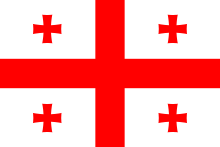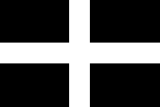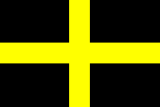- St George's Cross
-
Not to be confused with the Cross of St. George, a military distinction in Russia; or the highest civil distinction awarded in Catalonia; or the George Cross, a UK and Commonwealth medal.
St George's Cross (or the Cross of St George) is a red cross on a white background used as a symbolic reference to Saint George. The red cross on white was associated with St George from medieval times.
St George's Cross has been adopted on the coat of arms and flags of several countries and cities which have St George as a patron saint, notably England, Georgia, Aragon, Greece, Genoa and Barcelona.
The cross is also found, for various reasons, on the provincial flag of Huesca, Zaragoza and Teruel (the 3 provinces of Aragón) as well as the municipal flag for numerous cities, including Montreal, Almería, Milan, Genoa, Padua, Zadar and Freiburg im Breisgau. It is also the basis for the Four Moors flag of Sardinia. Guernsey was permitted to use it as its state flag between 1936 and 1985.
Historically, the cross appeared on many now extinct flags, emblems and coats of arms, such as that of the Swabian League in late Medieval Germany.
Contents
St George's Cross in England
In Legend
Like other countries with St George as a patron, the English frequently used St George's cross as their flag.
During the first Crusade, the Pope decided that knights of different nationalities should be distinguished by different colours of cross. French knights were allocated the red cross on white. English knights complained about this, since they considered this to be "their" St George's cross.
In 1188 the French King, Philip II of France accepted the claim of the English to the red cross on white,[1] and the English and French officially exchanged their respective crosses. However by this time, the red cross on white had become a typical crusader symbol.
Genoan origin
Historians believe that the St George's Cross was adopted from the flag of Genoa, where origins date back to 1096. The Genoese flag was adopted from the personal flag of St. Ambrose, the Fourth Century Bishop of Milan who was a key figure in the development of Christianity in the West. St. Ambrose's cross had become a symbol of Milan, then the wider areas of Northern Italy. (Because it was a common symbol in the region, it was the flag of the Lombard League, a coalition of city states including both Milan and Genoa that opposed Frederick Barbarossa in the 12th and 13th Century.) Genoa's patron saint was St. George, and its vast trading fleet carried the association between the flag and the Saint across the ports of Europe and the Mediterranean Sea. The flag was adopted by England and the City of London in 1190 for their ships entering the Mediterranean and in part on the Black Sea, to benefit from the protection of the Genoese fleet. The English Monarch paid an annual tribute to the Doge of Genoa for this privilege.
Prince Edward, Duke of Kent, supports this theory:
- "The St. George's flag, a red cross on a white field, was adopted by England and the City of London in 1190 for their ships entering the Mediterranean to benefit from the protection of the Geonoese fleet. The English Monarch paid an annual tribute to the Doge of Genoa for this privilege."[2]
At the beginning of the Crusades, a red cross on white was already associated with England because this was St George's cross, the emblem associated with England's patron saint. Although the Pope decided English crusaders would be distinguished by wearing a white cross on red, and French crusaders a red cross on white (Italian knights were allocated a yellow cross on a white background), English knights soon decided to claim "their" cross of red on white, like the French. In January 1188, Henry II of England and Philip II of France met and agreed to exchange flags (France later changed its new white cross on red for a white cross on a dark blue flag). Some French knights carried on using the red cross however, and as English knights wore this pattern as well, the red cross on white became the typical crusader symbol regardless of nationality. Since the King of France, Philip II, had already accepted that the red cross on white was an English symbol two years prior to 1190,[1] this shows that the duty was paid to the city of Genoa to definitively adopt the symbol and simultaneously provide protection from pirate attacks.
Middle Ages
From about 1277, due to already widespread use, St George's cross officially became the national flag of England. The three lions remained the coat of arms and flag of the king.
After the dynastic union of England and Scotland in 1603 (the so-called "Union of the Crowns"), a combined British flag was created in 1606, initially for maritime display, later restricted to the King's ships, by combining St George's Cross with the St Andrew's Cross (the flag of Scotland). The St George flag remained the flag of England for other purposes until the Acts of Union 1707. At the union, the first Union Flag become official for all purposes in the new Kingdom of Great Britain.
Modern usage
Nevertheless, in heraldry the St George's Cross continued to be used in the fly of standards in English grants of arms. It is still used to represent England and by those who wish to show pride in England specifically. Nowadays this is primarily done at events such as international football and rugby union competitions.
The flag of St George is also the rank flag of an Admiral in the Royal Navy, and civilian craft are forbidden to fly it. However, ships which took part in the rescue operation at Dunkirk during World War II are allowed to fly it as a jack.
Churches belonging to the Church of England (unless for special reasons another flag is flown by custom) may fly the St George's Cross. The correct way (since an order from the Earl Marshal in 1938) is for the church to fly the St George's cross, with the arms of the diocese in the left-hand upper corner of the flag.[3]
The flag of St George has since the late 20th century enjoyed a resurgence in popularity partly due to football-inspired nationalism, and also in response to the devolution movements in Scotland and Wales.[4]
On 24th May 2010, during the England-Mexico friendly football game at Wembley Stadium, England fans formed the largest ever St. George's Cross.
During the 2010 World Cup the UK Prime Minister, David Cameron, told Parliament that the flag would fly above his official residence at "no extra cost to the tax payer" whilst England played in the contest. This was partly to gather support for the team, and also a joking comment about the then current UK government cutbacks.
St George's Cross in other European countries
Saint George is the patron saint of England, Catalonia, Aragon and of various other countries and regions. The St George's Cross is a traditional symbol in the Kingdom of Aragon since the 13th century, and it appears in the flags of the provinces of Huesca, Zaragoza and Teruel and in the coat of arms of Aragon. The St George's Cross is also the symbol of Bologna, Freiburg, Genoa and Milan; and is used in three other European countries. It was used on the coat of arms of the Archbishopric of Trier. On the flag of the city of Barcelona it is quartered with the arms of the Crown of Aragon; on the flag of Georgia it is accompanied by four small red crosses.
The cross is also used extensively across Northern Italy, including most notably Milan, where it is often still referred to as the "Cross of St. Ambrose." The Lega Nord, a popular Italian political party campaigning for the independence of Northern Italy, also uses the St George's Cross as an official symbol.
The flag of St George should not be confused with the similar flag of the Red Cross. The cross of St George reaches from edge to edge of the oblong flag. The flag of the Red Cross, like the Swiss flag, has a greek cross (meaning the arms are of equal length) which does not touch any of the flag edges.
The first Hungarian king Saint Stephen led his army under Saint George's flag.
St George's Cross in the United States
For centuries, and as carried by crusaders throughout Europe during the crusades, it has long been referred to as "God's Flag". This interpretation of the Flag of Saint George as "God's Flag" was carried to America by early members of the Church of England and Anglican community in early American history. Rather than representing English nationality, and instead recognized in the United States as "God's Flag", provisions have been made in United States Code (US Flag Code as specified in 4 USC Title 7) as the only flag allowed to fly higher than the US national flag in certain highly restricted circumstances—specifically, only during church services for naval personnel when these services are conducted by a naval chaplain while on a vessel at sea, and even then only in pennant form. During the 21st century the US Navy has adopted a navy church pennant that replaces the red cross of St George with a blue cross.
St George's Cross in Georgia
The flag with St George (who is the patron saint of Georgia) cross was used in 5th century by the Georgian King Vakhtang Gorgasali as the symbol of his state and nation.[5][dubious ] In 13th century Queen Tamar of Georgia used the St. George flag during her campaign against Seljuk Turks. The four Jerusalem crosses were later added by King George V of Georgia who drove out the Mongols from Georgia in 1334. The flag fell out during the Russian annexation of Georgia and abolition of the Georgian monarchy. However the flag was revived by the Georgian patriotic movement in the 1990s. A majority of Georgians, including the influential Catholicos-Patriarch Ilia II of the Georgian Orthodox and Apostolic Church, supported the restoration of medieval flag of Georgia. The flag was finally adopted by the Georgian parliament on January 14, 2004. It was formally endorsed by a presidential decree signed by Mikheil Saakashvili on January 25, following his election as President of Georgia.
St George's Cross in New South Wales
The state badge of the Australian state of New South Wales features St. George's cross with a golden lion passant guardant in the centre of the cross and a golden eight pointed star on each of the cross limbs.
St George's Cross in Sardinia
The flag of the Italian Region of Sardinia, popularly known also as the Four Moors flag, consists of a red cross on a white background, with a maure (moor's head) in each quarter. The Flag of Sardinia, according to the Iberic tradition, was created by King of Aragon Peter I after the victory of Alcoraz (1096) in the city of Huesca, Aragón. The battle was won with the help of St. George, therefore the red cross, who abandoned on the battle field the heads of the four defeated Moorish kings.
St George's Cross in Sweden
In Sweden and Scandinavia the definition of a St George's cross is extended to also include a centred cross, normally red but not necessarily, with triangular arms that do not fill the square.[6] Internationally this is often referred to as a subgroup of Cross pattée, although this type of cross is sometimes not included in the Cross pattée variations.
For example is the cross of the Swedish Order of Freemasons defined back in 1928 by the King of Sweden to be a red St George's cross with triangular arms.
In Finnish the Cross pattée -type is called merely "Yrjön risti", Georges cross, while the red cross on a white background is called "Pyhän Yrjön risti", Saint Georges cross.[7]
Gallery
-
Flag of Genoa
-
Flag of Greece (1828-1978)
-
Flag of Cornwall
-
Former flag of Northern Ireland
-
Flag of the Kingdom of Asturias
-
Coat of arms of the Archbishopric of Trier
-
The Coat of Arms of the Canadian Province of Ontario
-
Flag of Amersfoort
-
Coat of arms of Konstanz (district)
-
Flag of the Palaiologan Byzantine Empire
-
Coat of Arms of Aragon
-
The United Kingdom's White Ensign
-
The Coat of Arms of the Canadian Province of Alberta
-
Flag of Guernsey
-
Flag of Alderney
-
Flag of Sark
-
The Coat of Arms of the City of York, England
-
Flag of Herm
-
Flag of the City of Nanaimo, British Columbia, Canada
-
Coat of arms of the 16th century Swabian League with a St George's Cross (colored woodcut by Hans Burgkmair, 1522).
See also
Notes
- ^ a b Prof. J. Prawer, A history of the Latin Kingdom of Jerusalem (Hebrew, 3rd edition, vol. II, pp. 17-18)
- ^ Padiglione Britannico presente all'Expo Colombiana a Genova, 1992 (Welcome to the British Pavilion). A Bilingual message from the Duke of Kent
- ^ Church of England - Use of the flag; Flags of the World; 23 October 2008
- ^ [1]
- ^ Theodore E. Dowling, Sketches of Georgian Church History, New York, p 54
- ^ Nationalencyklopedin. "Georgskors", http://www.ne.se/georgskors retrieved on 2010-08-12.
- ^ Kimmo Kara, Vaakunaselitys, Helsinki 1989, ISSN 0784-7602, p 49-51
External links
- Flag of England at FOTW
- Banners of English saints at FOTW
Categories:- Flags of England
- Cross symbols
- Catalan symbols
- Flags of saints
- Heraldic charges
Wikimedia Foundation. 2010.



































